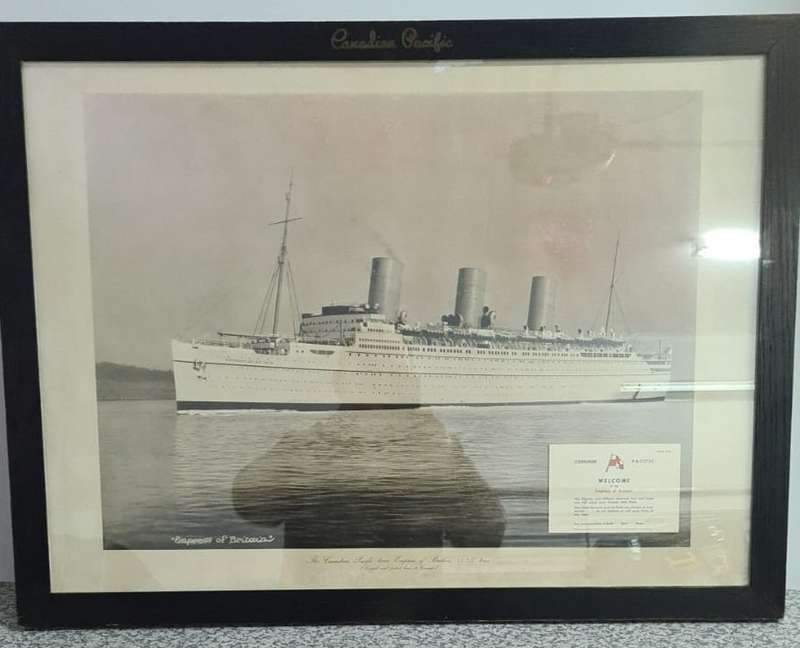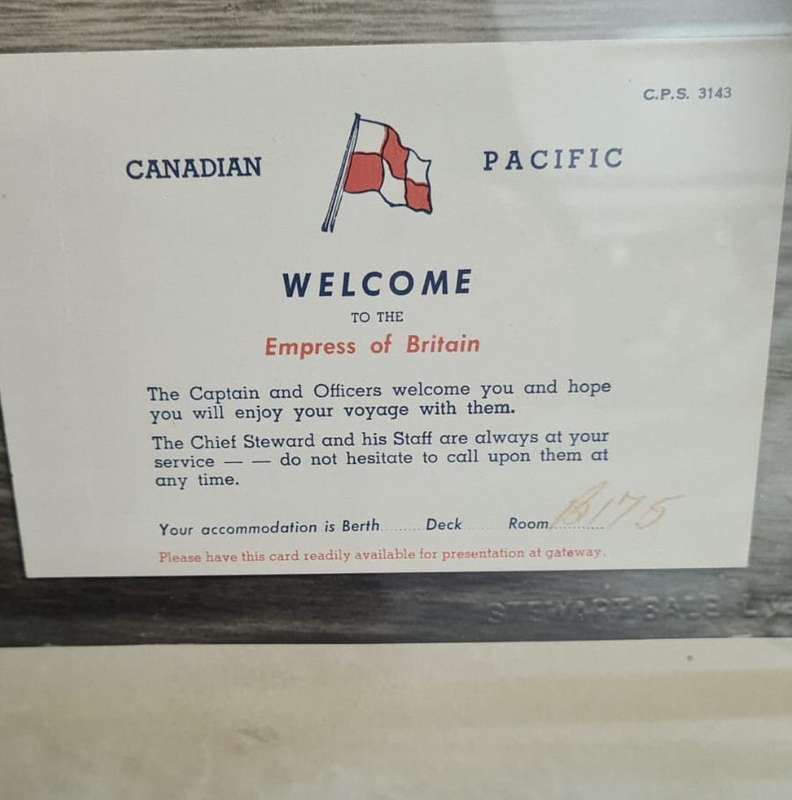This is an official print of the RMS Empress of Britain, in an official Canadian Pacific frame. A Empress of Britain Boarding Pass is included. This was originally owned by Gerald Flak, who had one of the largest maritime collections in the world and lived in Cape Town, South Africa. He passed away about 5 years ago. He had this item refurbished, reframed, and when it was reframed, he mounted the boarding pas in the frame with the print. It is in fine condition. (Below quoted from Wikipedia) On 25 November 1939, Empress of Britain was requisitioned as a troop transport. First, she did four transatlantic trips taking troops from Canada to England. Then she was sent to Wellington, New Zealand, returning to Scotland in June 1940 as part of the "million dollar convoy" of seven luxury liners Andes, Aquitania, Empress of Britain, Empress of Canada, Empress of Japan, Mauretania and Queen Mary.[26] In August 1940 Empress of Britain transported troops to Suez via Cape Town, returning with 224 military personnel and civilians, plus a crew of 419.[27] Sinking: At around 9:20 am on 26 October 1940, travelling about 70 miles northwest of Ireland along the west coast, Empress of Britain was spotted by a German Focke-Wulf Fw 200C Condor long-range bomber, commanded by Oberleutnant Bernhard Jope. Jope's bomber strafed Empress of Britain three times and struck her twice with 250 kg (550 lb) bombs. Only after Jope returned to base in northern France was it discovered which ship he had attacked. A telex was sent to German Supreme Headquarters. Realising the significance, a reconnaissance plane went to verify; and the German news agency reported that Empress of Britain had been sunk: "The Empress of Britain was successfully attacked by German bombers on Saturday morning within the waters of Northern Ireland. The ship was badly hit and began to sink at once. The crew took to their boats." Despite the ferocity of Jope's attack and the fires, there were few casualties. Bombs started a fire that began to overwhelm the ship. At 9:50 am, Captain Sapworth gave the order to abandon ship. The fire was concentrated in the midsection, causing passengers to head for the bow and stern, and hampering launching of the lifeboats. Most of the 416 crew, 2 gunners, and 205 passengers were picked up by the destroyers HMS Echo and ORP Burza, and the anti-submarine trawler HMS Cape Arcona. A skeleton crew remained aboard. The fire left the ship unable to move under her own power, but she was not sinking and the hull appeared intact despite a slight list. At 9:30 am on 27 October, a party from HMS Broke went on board and attached tow ropes. The oceangoing tugs HMS Marauder and HMS Thames had arrived and took the hulk under tow. Escorted by Broke and HMS Sardonyx, and with cover from Short Sunderland flying boats during daylight, the salvage convoy made for land at 4 kn (7.4 km/h). The German submarine U-32, commanded by Hans Jenisch, had been told and headed in that direction. He had to dive due to the flying boats, but that night, using hydrophones (passive sonar), located the ships and closed in on them. The destroyers were zigzagging in escort; U-32 placed herself between them and Empress of Britain, from where she fired two torpedoes. The first detonated prematurely; the second, however, hit, causing a massive explosion. Crews of the destroyers speculated this was caused by the fires aboard the liner reaching her fuel tanks. Jenisch manoeuvred U-32 and fired a third torpedo, which hit the ship just aft of the earlier one. The ship began to fill with water and list heavily. The tugs slipped the tow lines and at 2:05 am on 28 October, Empress of Britain sank northwest of Bloody Foreland, County Donegal, Ireland at 55°16N 09°50W.[28]





